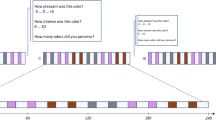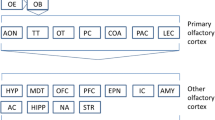Abstract
The volume of the olfactory bulb (OB) is strongly reduced in patients with major depressive disorder (MDD) and this group exhibits markedly decreased olfactory function. It has been suggested that olfactory input is important for maintaining balance in limbic neurocircuits. The aim of our study was to investigate whether reduced OB volume is associated with response to therapy in MDD. Twenty-four inpatients (all women, age 21–49 years, mean 38 ± 10 years SD) with MDD and 36 healthy controls (all women, age 20–52 years, mean 36 ± 10 years SD) underwent structural MRI. OB volume was compared between responders (N = 13) and non-responders (N = 11) to psychotherapy. Retest of OB volume was performed about 6 months after the end of therapy in nine of the patients. Therapy responders exhibited no significant difference in OB volume compared to healthy controls. However, average OB volume of non-responders was 23 % smaller compared to responders (p = .0011). Furthermore, OB volume was correlated with the change of depression severity (r = .46, p = .024). Volume of the OB did not change in the course of therapy. OB volume may be a biological vulnerability factor for the occurrence and/or maintenance of depression, at least in women.


Similar content being viewed by others
References
Beck, A. T., Steer, R. A., & Brown, G. K. (1996). Beck depression inventory (2nd ed.). San Antonio: Pearson.
Bergmann, O., Liebl, J., Bernard, S., Alkass, K., Yeung, M. S., Steier, P., . . . Frisen, J. (2012). The age of olfactory bulb neurons in humans. Neuron, 74(4), 634–639. doi:10.1016/j.neuron.2012.03.030.
Betchen, S., & Doty, R. L. (1998). Bilateral detection thresholds reflect the functioning of the best nasal chamber in dextrals and sinistrals. Chemical Senses, 23, 453–457.
Buschhuter, D., Smitka, M., Puschmann, S., Gerber, J. C., Witt, M., Abolmaali, N. D., & Hummel, T. (2008). Correlation between olfactory bulb volume and olfactory function. NeuroImage, 42(2), 498–502. doi:10.1016/j.neuroimage.2008.05.004.
Croy, I., Negoias, S., Novakova, L., Landis, B. N., & Hummel, T. (2012). Learning about the functions of the olfactory system from people without a sense of smell. PLoS One, 7(3), e33365. doi:10.1371/journal.pone.0033365.
Croy, I., Negoias, S., Symmank, A., Schellong, J., Joraschky, P., & Hummel, T. (2013). Reduced olfactory bulb volume in adults with a history of childhood maltreatment. Chemical Senses, 38(8), 679–684.
Croy, I., Nordin, S., & Hummel, T. (2014a). Olfactory disorders and quality of life–an updated review. Chemical Senses, 39(3), 185–194. doi:10.1093/chemse/bjt072.
Croy, I., Symmank, A., Schellong, J., Hummel, C., Gerber, J., Joraschky, P., & Hummel, T. (2014b). Olfaction as a marker for depression in humans. Journal of Affective Disorders, 160, 80–86.
Doty, R. L., & Cameron, E. L. (2009). Sex differences and reproductive hormone influences on human odor perception. Physiology and Behavior, 97(2), 213–228. doi:10.1016/j.physbeh.2009.02.032.
Folstein, M. F., Folstein, S. E., & McHugh, P. R. (1975). “Mini-mental state”. A practical method for grading the cognitive state of patients for the clinician. Journal of Psychiatric Research, 12, 189–198.
Frasnelli, J., Livermore, A., Soiffer, A., & Hummel, T. (2002). Comparison of lateralized and binasal olfactory thresholds. Rhinology, 40(3), 129–134.
Gottfried, J. A. (2006). Smell: central nervous processing. Advances in Oto-Rhino-Laryngology, 63, 44–69. doi:10.1159/000093750.
Gottfried, J. A., O’Doherty, J., & Dolan, R. J. (2003). Encoding predictive reward value in human amygdala and orbitofrontal cortex. Science, 301(5636), 1104–1107. doi:10.1126/science.1087919.
Gudziol, V., Buschhuter, D., Abolmaali, N., Gerber, J., Rombaux, P., & Hummel, T. (2009). Increasing olfactory bulb volume due to treatment of chronic rhinosinusitis–a longitudinal study. Brain, 132(Pt 11), 3096–3101. doi:10.1093/brain/awp243.
Haehner, A., Rodewald, A., Gerber, J. C., & Hummel, T. (2008). Correlation of olfactory function with changes in the volume of the human olfactory bulb. Archives of Otolaryngology - Head and Neck Surgery, 134(6), 621–624. doi:10.1001/archotol.134.6.621.
Haehner, A., Mayer, A. M., Landis, B. N., Pournaras, I., Lill, K., Gudziol, V., & Hummel, T. (2009). High test-retest reliability of the extended version of the “Sniffin’ Sticks” test. Chemical Senses, 34(8), 705–711. doi:10.1093/chemse/bjp057.
Hautzinger, M., Bailer, M., & Worall, H. (1995). Beck-Depressions-Inventar (BDI). Testhandbuch. Bern: Hans Huber.
Huart, C., Rombaux, P., & Hummel, T. (2013). Plasticity of the human olfactory system: the olfactory bulb. Molecules, 18(9), 11586–11600. doi:10.3390/molecules180911586.
Hummel, T., Kobal, G., Gudziol, H., & Mackay-Sim, A. (2007). Normative data for the “Sniffin’ Sticks” including tests of odor identification, odor discrimination, and olfactory thresholds: an upgrade based on a group of more than 3,000 subjects. European Archives of Oto-Rhino-Laryngology, 264(3), 237–243. doi:10.1007/s00405-006-0173-0.
Hummel, T., Haehner, A., Hummel, C., Croy, I., & Iannilli, E. (2013a). Lateralized differences in olfactory bulb volume relate to lateralized differences in olfactory function. Neuroscience, 237, 51–55. doi:10.1016/j.neuroscience.2013.01.044.
Hummel, T., Henkel, S., Negoias, S., Galvan, J. R., Bogdanov, V., Hopp, P., . . . Haehner, A. (2013). Olfactory bulb volume in patients with temporal lobe epilepsy. Journal of Neurology, 260(4), 1004–1008. doi:10.1007/s00415-012-6741-x.
Jacobson, N. S., & Truax, P. (1991). Clinical significance: a statistical approach to defining meaningful change in psychotherapy research. Journal of Consulting and Clinical Psychology, 59(1), 12–19.
Lotsch, J., Schaeffeler, E., Mittelbronn, M., Winter, S., Gudziol, V., Schwarzacher, S. W., . . . Ultsch, A. (2013). Functional genomics suggest neurogenesis in the adult human olfactory bulb. Brain Structure and Function. doi:10.1007/s00429-013-0618-3.
Lundstrom, J. N., Mathe, A., Schaal, B., Frasnelli, J., Nitzsche, K., Gerber, J., & Hummel, T. (2013). Maternal status regulates cortical responses to the body odor of newborns. Frontiers in Psychology, 4, 597. doi:10.3389/fpsyg.2013.00597.
Negoias, S., Croy, I., Gerber, J., Puschmann, S., Petrowski, K., Joraschky, P., & Hummel, T. (2010). Reduced olfactory bulb volume and olfactory sensitivity in patients with acute major depression. Neuroscience, 169(1), 415–421.
Pause, B. M., Raack, N., Sojka, B., Goder, R., Aldenhoff, J. B., & Ferstl, R. (2003). Convergent and divergent effects of odors and emotions in depression. Psychophysiology, 40(2), 209–225.
Rolls, E. T., Grabenhorst, F., & Parris, B. A. (2010). Neural systems underlying decisions about affective odors. Journal Cognitive Neuroscience, 22(5), 1069–1082. doi:10.1162/jocn.2009.21231.
Schablitzky, S., & Pause, B. M. (2014). Sadness might isolate you in a non-smelling world: olfactory perception and depression. Frontiers in Psychology, 5, 45. doi:10.3389/fpsyg.2014.00045.
Song, C., & Leonard, B. E. (2005). The olfactory bulbectomised rat as a model of depression. Neuroscience and Biobehavioral Reviews, 29(4–5), 627–647. doi:10.1016/j.neubiorev.2005.03.010.
Turetsky, B. I., Moberg, P. J., Yousem, D. M., Doty, R. L., Arnold, S. E., & Gur, R. E. (2000). Reduced olfactory bulb volume in patients with schizophrenia. The American Journal of Psychiatry, 157, 828–830.
Turetsky, B. I., Moberg, P. J., Arnold, S. E., Doty, R. L., & Gur, R. E. (2003). Low olfactory bulb volumes in first-degree relatives of patients with schizophrenia. The American Journal of Psychiatry, 160, 703–708.
Yousem, D. M., Geckle, R. J., Bilker, W. B., McKeown, D. A., & Doty, R. L. (1996). Posttraumatic olfactory dysfunction: MR and clinical evaluation. AJNR - American Journal of Neuroradiology, 17(6), 1171–1179.
Yousem, D. M., Geckle, R. J., Doty, R. L., & Bilker, W. B. (1997). Reproducibility and reliability of volumetric measurements of olfactory eloquent structures. Academic Radiology, 4(4), 264–269. doi:10.1016/S1076-6332(97)80027-X.
Yousem, D. M., Geckle, R. J., Bilker, W. B., & Doty, R. L. (1998). Olfactory bulb and tract and temporal lobe volumes. Normative data across decades. Annals of the New York Academy of Sciences, 855, 546–555.
Yousem, D. M., Geckle, R. J., Bilker, W. B., Kroger, H., & Doty, R. L. (1999). Posttraumatic smell loss: relationship of psychophysical tests and volumes of the olfactory bulbs and tracts and the temporal lobes. Academic Radiology, 6, 264–272.
Acknowledgments
This work was supported by a grant from the Roland Ernst Stiftung to TH and grant from the German Research Foundation to IC (DFG; CR 479/1-1).
Informed consent
All procedures followed were in accordance with the ethical standards of the responsible committee on human experimentation (institutional and national) and with the Helsinki Declaration of 1975, and the applicable revisions at the time of the investigation. The study was approved by the Ethics Committee from the Technical University of the Dresden Medical School (EK254102008). Informed consent was obtained from all patients for being included in the study.
Conflict of interest
Simona Negoias, Thomas Hummel, Anja Symmank, Julia Schellong, Peter Joraschky, and Ilona Croy declare that they have no conflicts of interest.
Author information
Authors and Affiliations
Corresponding author
Electronic supplementary material
Below is the link to the electronic supplementary material.
Supplementary Table S1
(DOCX 33 kb)
Rights and permissions
About this article
Cite this article
Negoias, S., Hummel, T., Symmank, A. et al. Olfactory bulb volume predicts therapeutic outcome in major depression disorder. Brain Imaging and Behavior 10, 367–372 (2016). https://doi.org/10.1007/s11682-015-9400-x
Published:
Issue Date:
DOI: https://doi.org/10.1007/s11682-015-9400-x




